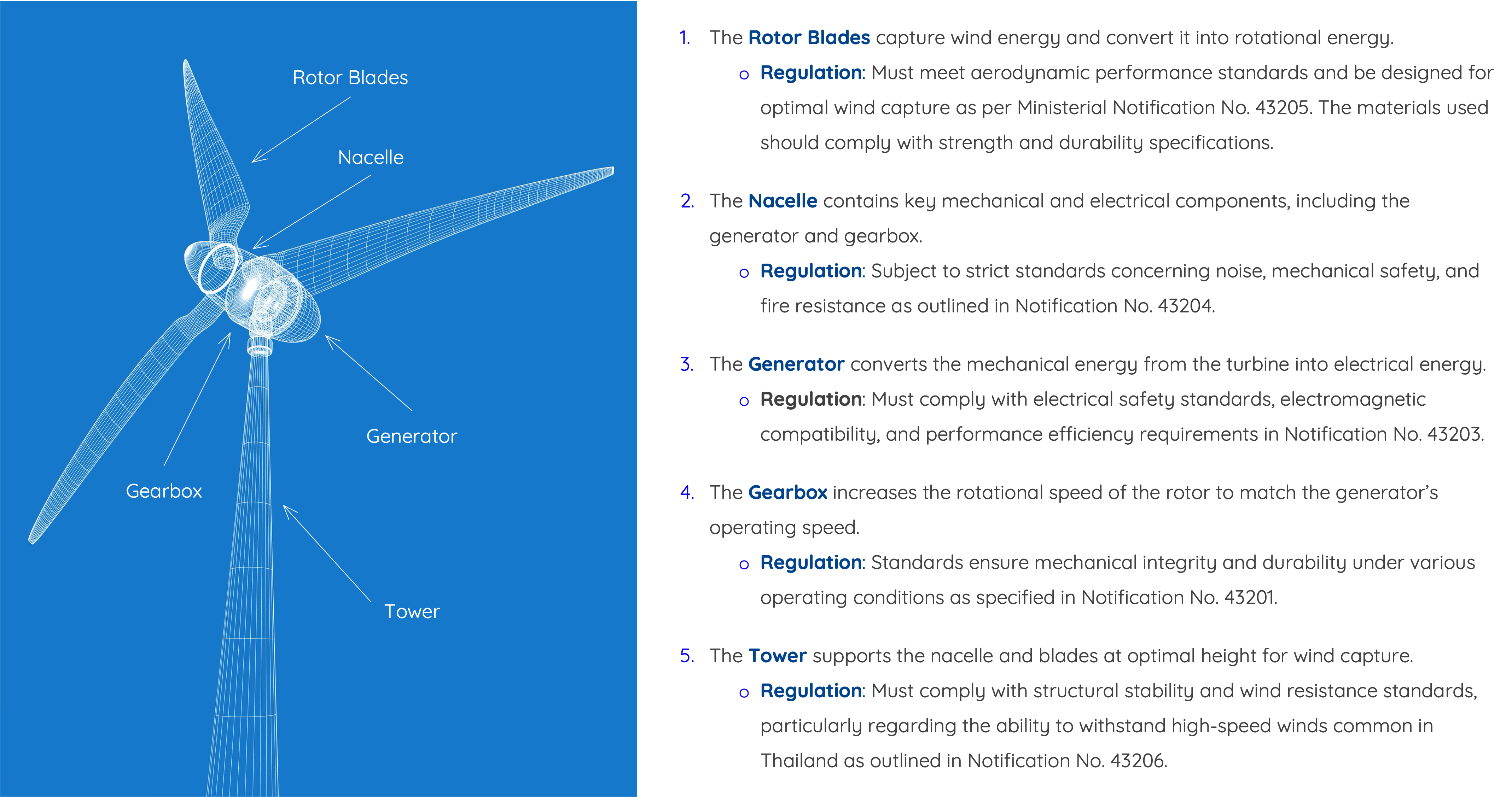Thailand has been progressively aligning its energy regulations with international standards, focusing specifically on renewable energy technologies, including wind power. The series of Ministerial Notifications prescribing standards for wind turbine generators and their parts, published in the Royal Gazette, reflects this regulatory approach. Below is an overview and analysis of the energy regulations in Thailand concerning wind turbine generators, based on the available notifications.
Overview of Energy Regulations for Wind Turbine Generators
1. Scope and Purpose: The notifications aim to establish clear standards for wind turbine generators and their components to ensure safety, performance, and durability. By aligning these standards with international best practices, Thailand seeks to promote the efficient deployment of wind energy technologies while safeguarding public safety and environmental interests.
2. Technical Specifications: The regulations provide detailed technical requirements for the design, construction, installation, and maintenance of wind turbines. These include specifications for:
⦾ Structural Integrity: Ensuring that the materials used in wind turbines are durable and resistant to the stresses caused by wind forces.
⦾ Safety Features: Requirements for braking systems, lightning protection, and fail-safe mechanisms that minimize the risk of accidents.
⦾ Performance Standards: Criteria that wind turbines must meet to ensure reliable and consistent energy production under varying wind conditions. These standards are crucial for ensuring that wind turbines operate efficiently and safely throughout their lifecycle.
3. Component Standards: Each part of the wind turbine, from the rotor blades to the nacelle and the tower, is subject to specific standards. These standards address factors such as:
⦾ Aerodynamics: Rotor blades must be designed to optimize energy capture while minimizing noise pollution and wear.
⦾ Mechanical Components: The drive train, gearbox, and other mechanical parts must meet rigorous performance standards to ensure long-term reliability.
⦾ Electrical Systems: Standards for generators and electrical connections are designed to ensure efficient conversion of wind energy into electricity and safe integration into the grid.
4. Regulatory Bodies and Compliance: The Department of Alternative Energy Development and Efficiency (DEDE) under the Ministry of Energy is the key regulatory body responsible for enforcing these standards. Wind energy developers must ensure that their equipment complies with these regulations, and periodic inspections are conducted to verify compliance.

Figure 1. Main components of a land-based gearbox turbine.
Non-compliance with these standards can result in penalties, including fines or the suspension of operating licenses. Thus, developers and manufacturers must work closely with regulatory bodies to ensure that their turbines meet all applicable requirements.
Key Insights and Implications
1. Alignment with International Standards: The notifications align Thailand’s wind energy regulations with international standards, including those set by the International Electrotechnical Commission (IEC). This ensures that wind turbines installed in Thailand are on par with global benchmarks for safety and performance, which is crucial for attracting international investment in the renewable energy sector.
2. Facilitating Renewable Energy Development: By creating a clear regulatory framework for wind turbines, Thailand is fostering a conducive environment for the growth of wind energy. These standards provide investors with the certainty they need to proceed with large-scale wind projects, knowing that the regulatory landscape is stable and predictable.
3. Focus on Safety and Environmental Impact: The detailed safety standards outlined in the notifications indicate a strong commitment to minimizing the risks associated with wind turbine installations. This includes not only protecting human life but also mitigating the environmental impacts of wind energy projects, such as noise pollution and the effect on local wildlife.
4. Challenges for Implementation: While the regulations provide a solid framework, their implementation may pose challenges, particularly in terms of ensuring that smaller developers have the resources to comply with the stringent standards. Ongoing government support, in the form of technical assistance or subsidies, may be necessary to help developers meet these requirements, especially in remote or less developed areas of Thailand.
Thailand’s adoption of comprehensive standards for wind turbine generators is a positive step towards expanding its renewable energy portfolio. These regulations provide clarity and security for developers and manufacturers, ensuring that wind energy projects are both safe and efficient. Moving forward, continued alignment with international standards and robust enforcement will be key to unlocking the full potential of wind energy in Thailand.